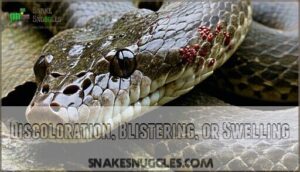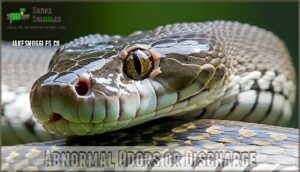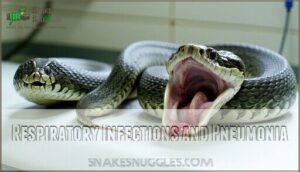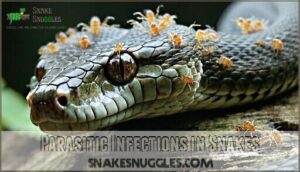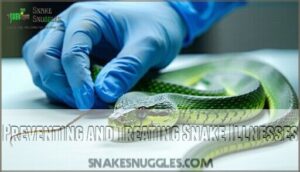This site is supported by our readers. We may earn a commission, at no cost to you, if you purchase through links.
 Common snake illnesses include respiratory infections, scale rot, and parasitic infestations, usually tied to improper care or stress.
Common snake illnesses include respiratory infections, scale rot, and parasitic infestations, usually tied to improper care or stress.
Watch for wheezing, bubbling around the nose, or open sores—these can signal big trouble.
Parasites like mites make snakes itchy and restless, while internal worms may cause weight loss despite normal feeding.
Skin problems like stuck shed or scale rot happen when humidity is off or hygiene slips, often leaving discolored or blistered scales.
Preventing issues is easier than treating them: keep the enclosure clean, maintain proper temperature and humidity, and watch for changes, as your slithery friend’s health depends on your keen eye to notice changes and prevent big trouble.
Table Of Contents
- Key Takeaways
- Signs of Illness in Snakes
- Physical Signs of Snake Illness
- Common Health Issues in Snakes
- Respiratory Problems in Snakes
- Skin and Shedding Issues in Snakes
- Common Snake Diseases
- Heart and Blood Vessel Disorders
- Digestive Disorders in Snakes
- Parasitic Infections in Snakes
- Preventing and Treating Snake Illnesses
- Frequently Asked Questions (FAQs)
- What diseases do snakes have?
- What are common snake conditions?
- Do pet snakes get diseases?
- What causes respiratory disease in snakes?
- What is snake fungal disease?
- How do snake diseases affect my pet reptile?
- What is the most common cause of death in snakes?
- What is an abnormal behavior of a snake?
- What are the signs of suffering in a snake?
- What diseases can snakes give you?
- Conclusion
Key Takeaways
- Monitor your snake for early signs of illness like changes in appetite, unusual behavior, or physical symptoms like discolored scales or respiratory problems.
- Keep the enclosure clean and maintain proper temperature, humidity, and ventilation to prevent infections and other health issues.
- Address parasites promptly—watch for mites, unusual skin irritation, or weight loss, and consult a vet for effective treatment.
- Act quickly if you notice concerning symptoms like wheezing, mouth discharge, or open sores—early vet care can prevent serious complications.
Signs of Illness in Snakes
When your snake isn’t feeling well, it often shows subtle signs that can be easy to miss if you’re not paying close attention.
Changes in appetite, lethargy, or unusual behavior like altered resting positions might be your first clues that something’s wrong, and recognizing these subtle signs can be crucial for a snake’s health, as they may indicate a need for close attention.
Recognizing subtle changes in your snake’s behavior can be the key to protecting its health and ensuring early care.
Changes in Appetite or Feeding Habits
A snake’s appetite can tell you a lot about its health. Sudden refusals to feed, unexpected weight fluctuation, or regurgitation causes concern.
Look out for:
- Snake regurgitation after meals.
- Eating irregular amounts or skipping meals entirely.
- Challenges like snake constipation or anorexia.
- Risky force-feeding attempts.
Check prey size and diet consistency—both impact snake nutrition. Behavior shifts shouldn’t be ignored—something deeper might be wrong.
Altered Activity Levels or Lethargy
It’s easy to miss lethargy in snakes, but it’s often a big red flag for deeper problems.
From stress to dehydration or infections, altered activity levels point to possible snake illnesses.
Pay close attention to these signs:
- **Shifts in basking or exploring behaviors.
- **Delayed responsiveness to handling or movement.
- **Weakened muscle tone or reduced grip strength.
- **Prolonged inactivity outside of natural hibernation.
If your snake seems "off," consider the causes of lethargy and seek prompt snake veterinary care.
Early action can prevent serious lethargy impacts!
Unusual Posturing or Resting Positions
Unusual posturing could mean spinal abnormalities, neurological issues, or muscle weakness.
Look for head tilting, neck stretching, or odd body angles. Healthy snakes rest in loose coils, so stiff or limp positions may signal dehydration, thermal regulation problems, or snake neurological signs.
| Symptom | Possible Cause | Action |
|---|---|---|
| Head tilting | Neurological issues | Vet visit |
| Stiff posture | Muscle weakness | Assess hydration |
| Limp body | Spinal abnormalities | Evaluate enclosure heat |
Increased Aggression or Defensiveness
A sudden shift in your snake’s behavior, like unexpected aggression, often hints at stress, pain, or underlying illness affecting their temperament.
Snakes in discomfort may lash out more, making handling challenging. Stress indicators like defensive coiling or hissing can arise from poor husbandry or habitat changes.
Watch for these signs:
- Increased striking during normal handling or feeding sessions.
- Defensive behaviors triggered by environmental factors.
- Sudden temperament changes, possibly linked to neurological issues or snake illnesses.
Physical Signs of Snake Illness
If you’re spotting changes in your snake’s skin, scales, or overall appearance, it’s a definite red flag.
Physical signs like sores, swelling, or unusual discharge can point to serious health issues that need your attention.
Lesions, Wounds, or Open Sores
Lesions, wounds, or open sores on your snake demand quick attention.
Even small cuts can lead to serious skin infections, bacterial issues, or scale damage, especially in humid enclosures.
Check for sharp edges in the habitat to prevent future mishaps.
Clean wounds gently to promote healing and prevent scarring.
For severe cases of snake trauma, bacterial infections, or fungal infections, don’t hesitate—contact a vet immediately to guarantee your pet’s recovery and prevent serious infections.
Scales Coming Loose or Falling Off
Shedding problems or loose scales aren’t normal outside regular shedding cycles and can point to serious issues, like trauma, scale rot, or environmental problems.
To prevent complications, monitor your snake’s scales closely.
Here’s what to watch for:
- Patches of missing scales.
- Areas with loosened scales.
- Signs of snake scale rot or infections.
- Injuries from trauma.
- Nutritional deficiencies linked to poor shedding.
Stay vigilant!
Discoloration, Blistering, or Swelling
Spotting discolored patches, blisters, or swelling on your snake isn’t just cosmetic—it’s often a red flag for health problems like infections or scale rot.
Healthy snake skin typically looks smooth and uniform, so these changes mean it’s time to act.
Pay attention to:
- Scale discoloration, such as red or dark patches that linger past shedding.
- Blister causes like overly humid enclosures or dirty conditions, leading to fluid-filled sores.
- Soft swelling origins near joints or under scales, possibly tied to infections.
- Infection signs, including redness or tenderness on affected areas.
Quick attention can prevent bigger issues like tissue damage or systemic problems.
Abnormal Odors or Discharge
Abnormal odors or discharge can signal serious snake illnesses like bacterial or fungal infections.
A foul fecal odor or unusual urates might point to cloacal swelling or digestive issues, while sticky residue or mouth discharge could suggest infected wounds or snake mouth rot.
Here’s a quick guide:
Warning Signs
When in doubt, call the vet.
Changes in Eye or Mouth Condition
When checking for odors, it’s worth inspecting your snake’s mouth and eyes for these warning signs:
- Eye cloudiness or sunken eyes, often tied to infections or shedding.
- Mouth discharge like thick mucus or bubbles near mouth sores.
- Swollen gums or irritated-looking oral tissue.
- A misshapen jaw, sometimes linked to snake mouth rot.
These symptoms could indicate snake illnesses, including mouth rot or eye conditions. If noticed, contact your vet immediately.
Common Health Issues in Snakes
Snakes can suffer from a variety of health issues, many of which are preventable with proper care.
From respiratory infections to parasite infestations, recognizing early signs is essential to keeping your snake healthy.
Respiratory Infections and Pneumonia
If your snake’s wheezing, has mucus bubbles around its nostrils, or breathes with its mouth open, it could signal a respiratory disease like bacterial pneumonia, viral pneumonia, or even fungal infections.
Poor husbandry impacts health—imbalances in humidity and ventilation often trigger snake respiratory infections.
Snake lungs are delicate, so act fast to improve tank conditions and seek veterinary care before the infection spreads or worsens into more severe complications like snake pneumonia.
External Parasites and Mites
External parasites like snake mites and ticks can make your scaly friend miserable. These pests, tiny but relentless, feed on blood and cause irritation.
Watch for these signs of a snake parasite infection:
- Tiny black dots moving sneakily over scales.
- Over-soaking in the water bowl, seeking relief.
- Frequent rubbing against decorations for itching.
- Small scars or scale damage appearing out of nowhere.
- White specks near eyes or heat pits, signaling stubborn mites.
Effective treatment options and environmental control guarantee relief! You can find snake mite treatments online.
Internal Parasites and Worm Infestations
Internal parasites can silently harm your snake. Look for weight loss, lethargy, or regurgitation—clues that something’s wrong. Worm segments in stool or a bloated belly might confirm suspicion.
Regular vet exams and fecal tests help catch these sneaky pests early. Dewormers and better hygiene can treat most cases. Protect your snake and avoid zoonotic risk with smart prevention.
| Worm Types | Diagnosis Methods | Treatment Options | Prevention Strategies |
|---|---|---|---|
| Roundworms | Fecal tests | Deworming medication | Clean enclosure, vet checks |
| Hookworms | Visual stool inspection | Anthelmintics | Quarantine new snakes |
| Pinworms | Fecal egg counts | Anthelmintics | Regular cleaning |
| Tapeworms | Weight loss observation | Veterinary care | Avoid contaminant buildup |
To ensure your snake’s health, it’s crucial to be aware of the signs of internal parasites and take preventative measures, including regular cleaning and quarantine of new snakes, to minimize the risk of infection and protect both your snake and yourself from potential health risks.
Bacterial and Fungal Infections
When bacterial dermatitis or snake fungal infections strike, your snake’s health could take a nosedive.
Often rooted in septicemia triggers like poor hygiene or injuries, these infections demand attention.
- Raised scales with redness and swelling underneath.
- Yellowish discharge resembling cheese around wounds.
- Musty odors hinting at fungal pneumonia or other problems.
Quick veterinary care combined with antibiotics or antifungals can save the day.
Prioritize preventative hygiene to keep snake skin infections at bay!
Metabolic Bone Disease and Nutritional Deficiencies
Weakness or deformed bone structure might mean your pet has metabolic bone disease. It’s a common issue caused by calcium deficiency or vitamin D3 shortages, often tied to dietary imbalance or insufficient UVB lighting.
Look for tremors, a soft jaw, or a bent spine. You might notice lethargy or your snake refusing food, all signs of snake nutritional deficiencies.
Prevent this by ensuring a balanced snake diet and proper lighting. A healthy snake won’t just survive—it’ll thrive, and that’s the goal!
Respiratory Problems in Snakes
If your snake starts wheezing or breathing with its mouth open, it’s a clear sign something’s off with its respiratory health.
These issues often result from poor enclosure conditions, so keeping the humidity and temperature just right is key to preventing problems.
Signs and Symptoms of Respiratory Infections
Spotting a snake respiratory infection early can make all the difference. These illnesses aren’t subtle, and your snake will show clear signs when something’s wrong.
Keep an eye (and ear!) out for these symptoms:
- Wheezing Sounds: If breathing produces whistling or gurgling noises, that’s a red flag.
- Open-Mouth Breathing: Snakes don’t pant—if it looks like they’re gasping, take note.
- Nasal Discharge: Watch for mucus or bubbles forming near their nostrils.
Be vigilant—respiratory disease often leads to lethargy signs, breathing difficulties, and appetite loss. Early detection means a better chance for recovery.
Causes of Respiratory Issues in Snakes
A snake’s respiratory tract is sensitive to environmental factors like poor ventilation, sudden temperature swings, or overly humid enclosures.
These conditions promote bacterial infections, fungal exposure, or viral pathogens.
Stressful husbandry deficiencies—like inadequate hiding spots—further weaken immunity, leaving your pet vulnerable to respiratory disease.
Preventing snake respiratory issues starts with stable temperatures and a well-maintained, clean habitat that avoids bacterial growth.
Importance of Proper Ventilation and Humidity
Think of proper ventilation and humidity levels as the backbone of good snake health. Without them, your snake’s respiratory health, shedding process, and overall wellbeing can take a hit.
Stale air and excessive moisture create the perfect storm for mold, bacteria, and shedding problems. Good ventilation systems guarantee airflow that matches your snake’s needs.
Set air changes per hour (ACH) between 2-4, and monitor humidity levels daily using a hygrometer. Here’s why these adjustments matter:
- Stops mold and bacteria in their tracks, reducing infection risks.
- Keeps your snake’s breathing smooth and stress-free.
- Regulates body temperature, improving snake husbandry.
- Prevents shedding issues linked to poor snake humidity levels.
Your efforts create a thriving snake environment!
Skin and Shedding Issues in Snakes
When your snake struggles with shedding or develops skin issues, it’s often linked to improper humidity or unclean enclosures.
Addressing these problems promptly is essential to prevent infections and keep their scales healthy.
Patchy Shedding and Dry Skin
Dealing with snake dysecdysis, or patchy shedding, often points to environmental factors like low humidity levels or poor snake husbandry.
Those stubborn skin patches? They’re your snake’s way of saying, "Something’s wrong."
Keep an eye on shedding frequency and watch for dry, flaky areas that hint at nutritional impact or even mite infestation.
Fine-tune the environmental conditions, ensuring proper warmth and moisture for seamless snake shedding and healthier skin.
Scale Rot and Fungal Infections
Scale rot and fungal infections are like unwanted pests—catching your snake off guard in damp, unclean conditions.
These snake skin conditions, such as scale rot and snake fungal disease, thrive in poor husbandry practices and lead to dangerous complications if ignored.
Watch for these symptoms:
- Reddish-brown blisters resembling small balloons under the scales.
- Scales lifting or peeling, hinting at infection.
- Dark, murky discoloration spreading across their belly scales.
- A strong, musty odor signaling possible bacterial growth.
Preventing infections starts with clean, dry enclosures and attention to humidity.
If you spot these signs, quick treatment options like antibiotics or antifungals can make the difference.
Ensuring Proper Humidity for Healthy Shedding
Healthy shedding starts with getting your snake’s humidity needs just right.
Ideal levels range from 50-70%—use a trusty hygrometer for humidity monitoring.
Spotting snake shedding problems? Gradually increase enclosure misting.
Substrate choice matters too—add damp moss or bark for hydration importance.
Keep up with snake enclosure cleaning and temperature requirements for a balanced environment.
Consider using a reliable snake hygrometer for accurate readings.
One tip: incomplete sheds mean your snake appreciates a more humid hide!
Common Snake Diseases
Snakes can suffer from a range of diseases, including infections, parasites, and respiratory issues, often caused by poor husbandry or environmental stress.
Recognizing these common illnesses early can make a big difference in keeping your snake healthy and thriving.
Infectious Stomatitis (Mouth Rot)
Mouth rot, a nasty snake bacterial infection, creeps in with symptoms like redness, swelling, pus, or even bleeding around the mouth.
Stress or poor care weakens your snake’s immunity, opening the door for infectious stomatitis. If your snake isn’t eating or drools excessively, it’s time to act.
Stomatitis treatment options like antibiotics and improved oral hygiene are critical. Preventing mouth rot starts with clean enclosures, proper humidity, and reducing stress factors to promote proper humidity.
Skin Infections
Skin infections, like bacterial dermatitis and fungal infections, can wreak havoc on your snake.
Watch for:
- Red, inflamed patches that seem irritated.
- Yellow crusts forming around scales, indicative of blister disease.
- Oozing bumps or sores on the skin.
- Darkened scales, possibly a sign of snake fungal diseases.
- Loose or peeling scales hinting at scale rot.
Preventative hygiene is your best ally.
Clean their enclosure regularly, maintain proper humidity, and check for irregularities.
Your snake’s scales depend on it!
Respiratory Disease
Respiratory disease in snakes can leave your companion struggling with wheezing, gurgling sounds, and open-mouth breathing.
It’s often tied to poor enclosure conditions, like incorrect humidity or ventilation, and caused by bacteria, fungi, or viruses.
| Symptom | Cause | Solution |
|---|---|---|
| Snake breathing difficulties | Fungal Infections | Adjust humidity, vet care |
| Snake open-mouth breathing | Viral Causes | Antibiotics/advice |
| Gurgling sounds | Pneumonia Types | Improve ventilation |
Treatment options include antibiotics, antifungals, and better enclosure care to address the root causes of respiratory issues, such as poor enclosure conditions, and to alleviate symptoms like open-mouth breathing.
Septicemia
Septicemia, or snake bloodstream infection, is a bacterial nightmare that can quickly turn deadly.
Watch for a reddened belly, labored breathing, and lethargy—subtle signs your snake’s in trouble.
Purple-red spots under the scales may appear, paired with muscle weakness or twitching.
Causes often trace to untreated wounds or poor conditions.
A vet’s quick diagnosis and antibiotic treatment are essential to save your scaly pal.
Viral Diseases
Viral diseases in snakes aren’t just a nuisance—they’re serious threats that need your attention.
Some, like inclusion body disease (IBD), lead to stargazing and neurological issues. Others, such as nidovirus infections, attack the respiratory system.
Watch for signs of snake viral infection: lethargy, breathing issues, or odd postures.
- IBD Transmission: Often fatal, especially in boas and pythons.
- Paramyxovirus Effects: Open-mouth breathing and tremors.
- Adenovirus Impact: Liver damage and weight loss.
Heart and Blood Vessel Disorders
Snakes can suffer from heart and blood vessel disorders like heart failure and blood clots, which may lead to serious health issues if left untreated.
Understanding the signs, such as lethargy or difficulty moving, helps you act quickly to protect your pet’s health.
Heart Failure
Heart problems in snakes, like heart failure, can develop silently but strike fast.
Watch for Congestive Symptoms like trouble breathing, a swollen belly, or lethargy. If you see a blue tinge on your snake’s scales, it’s time for an emergency vet visit!
Cardiac Diagnostics, such as imaging, can reveal issues early. Some snakes may have Genetic Predisposition to heart issues.
Preventative Measures, like proper care and annual checkups, offer the best Treatment Options for a healthy snake heart.
Blood Clots
Blood clots in snakes arise from dehydration, poor circulation, or health issues, causing severe complications like snake heart or circulatory failure.
Watch for symptoms like swelling, sluggishness, or unusual lumps.
- Diagnosis: A vet uses imaging or tests to locate clots.
- Treatment: Vets may prescribe medication or surgery for severe cases.
- Prevention: Make certain of hydration, proper temperature, and stress-free handling to reduce risks.
Stay proactive!
Septicemia and Its Effects on The Heart
Snake infections, like septicemia, can seriously harm your snake’s heart.
Once bloodstream bacteria spread, organ damage, including cardiac manifestations, becomes likely.
Watch for red belly spots, strange breathing, or lethargy—these signs scream trouble.
Snake blood infections progress fast, weakening the snake heart.
Don’t wait; a vet is your best bet for treatment options.
Prevention strategies, like a clean habitat and routine care, keep those sneaky snake bacterial infections far away.
Digestive Disorders in Snakes
Digestive disorders in snakes can cause symptoms like regurgitation, diarrhea, or bloating, often due to parasites, infections, or improper feeding.
You’ll need to act quickly to identify and address these issues, as untreated conditions can seriously affect your snake’s health.
Adenoviruses and Their Effects
Adenoviruses are sneaky culprits behind snake viral infections, particularly impacting young or immune-compromised species.
These viral diseases spread via fecal-oral transmission and cause liver disease, digestive impact, and rapid decline.
- Recognize symptoms like lethargy, anorexia, and sudden weight loss.
- Request PCR diagnosis from your veterinarian for accuracy.
- Provide supportive care including hydration and assisted feeding.
- Quarantine new arrivals to prevent spread among species susceptible to snake adenovirus infections.
Gastrointestinal Parasites
Dealing with gastrointestinal parasites in your snake? These unwelcome guests disrupt digestion, causing weight loss and lethargy.
Regular fecal exams and proper snake care prevent infestations.
Here’s a quick guide:
| Symptom | Indicator |
|---|---|
| Weight loss | Persistent |
| Lack of appetite | Noticeable |
| Abnormal stool | Watery/mucus |
| Parasites in stool | Visible |
| Restlessness | Behavioral |
Effective snake deworming and hygiene stops the parasite lifecycle, keeping snakes parasite-free.
Intestinal Blockages
Intestinal blockages in snakes, often caused by substrate or foreign objects, can wreak havoc on their digestive system.
Symptoms like lethargy, a bloated appearance, or appetite loss signal trouble.
Preventative measures include using safe bedding and minimizing risks of impaction causes.
For severe cases involving snake gastrointestinal issues, treatment might involve soaking to ease discomfort or surgical removal.
Adequate dietary fiber supports healthy snake intestinal function, reducing risks.
Parasitic Infections in Snakes
Caring for your snake isn’t just about feeding and housing. It’s also about keeping an eye out for parasites, the tiny troublemakers that can cause big problems.
Snake parasitic infections often involve internal parasites like helminths or protozoal parasites, while external parasites include ticks and mites. These uninvited pests can sap nutrients and spread infections.
Symptoms of snake parasites include unusual lethargy, unexplained weight loss, and visible bumps or tiny creatures crawling on the skin. Mite infestations, for instance, can irritate your snake and even carry diseases.
Left untreated, severe cases can lead to sepsis or other serious complications.
Treatment options usually involve antiparasitic medications and scrupulous enclosure cleaning to eliminate lingering pests.
-
Common signs to watch for:
- Unusual irritability or restlessness
- Changes in appetite or shedding patterns
- Skin darkening or visible mites
Regular vet checks keep parasites in check!
Preventing and Treating Snake Illnesses
You can keep your snake healthy by maintaining a clean, well-regulated enclosure and monitoring its behavior for any changes.
Regular check-ups with a qualified veterinarian guarantee early detection and treatment of potential health issues, keeping your scaly friend safe and thriving.
Proper Enclosure Setup and Maintenance
Your snake’s enclosure is like its sanctuary—it should fit its size comfortably to reduce stress.
Choose substrates like coconut fibers for softness and hygiene. Maintain proper environmental conditions with a temperature gradient and controlled humidity.
Add hiding spots for privacy, and stick to a regular cleaning schedule for snake cage cleaning.
A suitable habitat requires proper snake supplies for its well-being. Good enclosure maintenance guarantees your snake stays healthy and content.
Andless and His Effects on The Heart
Snake cardio care isn’t about guesswork; think of it as nurturing their tiny, scaly ticker. “Andless,” while mysterious-sounding, refers to heart-related challenges in snakes. A strong circulatory system equals a vibrant, slithery companion!
Keep heart health superior with these steps:
- Nutrition: A balanced diet fuels their heart like premium gas in a sports car.
- Hydration and Humidity: Proper water availability supports snake blood functions.
- Stress Control: Frequent handling stresses their snake circulatory system.
Watch for Andless symptoms like lethargy and odd behavior. Snake cardiology treatment options work, but prevention tips—like steady temps and early observation—are lifesavers!
Routine Veterinary Check-ups
Think of routine checkups as your snake’s secret weapon for a long life.
Early detection through fecal exams, husbandry reviews, or quarantine protocols stops small issues from snowballing.
A specialized snake veterinary visit assesses snake symptoms, encourages preventative care, and guarantees high-quality snake treatment.
It’s peace of mind for you and one smooth, healthy slither for your scaly pal!
Maintaining Proper Temperature and Humidity
Healthy enclosures depend on balanced temperature gradients and humidity levels.
To shield your snake from illnesses:
- Warm vs. Cool Areas: Provide temperature zones to meet snake temperature requirements.
- Species Needs: Match snake humidity levels to its natural environment.
- Monitoring Tools: Use thermostats and hygrometers for precision.
- Seasonal Adjustments: Adapt settings as seasons change to maintain stability.
Comfort equals prevention!
Frequently Asked Questions (FAQs)
What diseases do snakes have?
Snakes face diseases like mouth rot, respiratory infections, and septicemia.
Parasites, such as mites and helminths, often cause trouble too.
Watch for symptoms like lethargy, weight loss, or unusual behavior—early care makes a difference!
What are common snake conditions?
Imagine your scaly friend struggling; it’s heartbreaking.
Common snake conditions include respiratory infections, parasites, mouth rot, septicemia, and skin ailments.
Regular check-ups, clean habitats, and proper care help keep your slithering buddy happy and healthy.
Do pet snakes get diseases?
Yes, pet snakes can get diseases like respiratory infections, mouth rot, and parasites.
Symptoms vary but often include lethargy, weight loss, or odd behavior.
Keeping their habitat clean and well-maintained helps prevent respiratory infections and other issues, and is key to maintaining their health through proper maintenance.
What causes respiratory disease in snakes?
Nearly 70% of respiratory issues in snakes stem from poor husbandry, like incorrect humidity or low temperatures.
Bacteria, viruses, and fungi thrive in such conditions, causing wheezing, nasal discharge, and open-mouth breathing.
Proper care prevents it!
What is snake fungal disease?
Snake fungal disease (SFD) is a serious skin infection caused by the fungus Ophidiomyces ophiodiicola.
It causes scaly lesions, swelling, and crusting.
Early treatment with antifungals and better habitat hygiene helps snakes recover from SFD.
How do snake diseases affect my pet reptile?
Snake diseases can cause serious issues like lethargy, breathing trouble, or weight loss, often stemming from infections or poor care.
Quick vet visits and good husbandry keep your slithery friend thriving without unwanted drama, and quick action can prevent serious health issues.
What is the most common cause of death in snakes?
The most common cause of death in snakes is septicemia, a bacterial bloodstream infection.
It sneaks in through wounds, stress, or dirty enclosures, rapidly overwhelming their system.
Prompt care and clean habitats can save lives, emphasizing the importance of clean habitats.
What is an abnormal behavior of a snake?
When your snake starts refusing food, becomes unusually aggressive, or stays out in the open instead of hiding, it’s a red flag.
These behaviors often point to stress, illness, or improper enclosure conditions.
What are the signs of suffering in a snake?
When your scaly companion seems off, watch for lethargy, appetite loss, open-mouth breathing, discolored skin, or unusual behaviors like frequent hiding.
These can signal discomfort or illness—time to consult a vet for guidance!
What diseases can snakes give you?
You can catch diseases like Salmonella from snakes, usually through contact with their feces or contaminated surfaces.
Practice good hygiene—just washing your hands after handling them can strike a winning defense against these germs!
Conclusion
Keeping your snake healthy isn’t just about avoiding hiccups—it’s about ensuring they thrive.
By recognizing signs of common snake illnesses, like respiratory issues or scale rot, and maintaining ideal conditions, you’re setting them up for success.
A clean enclosure, balanced humidity, and proper nutrition go a long way in preventing problems.
Stay watchful for behavioral or physical changes, as early intervention makes a world of difference, and remember, your snake’s health truly depends on your care and attention!



